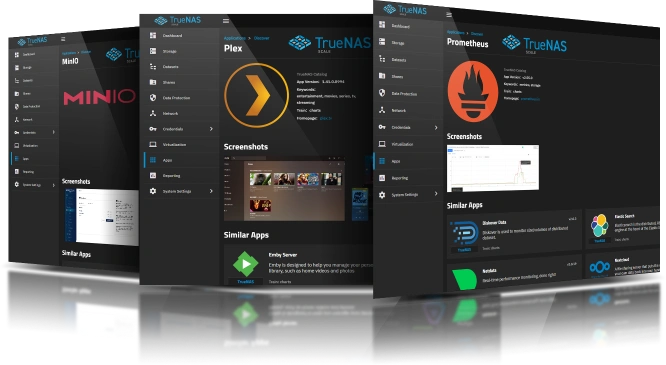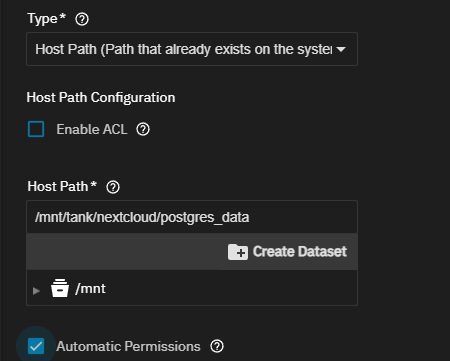App Storage
Applications in TrueNAS make use of a variety of dataset types for app storage.
The ix-apps dataset is the base-level storage volume for app data. Additionally, configuration options for individual apps include one or more of the following storage types: ixVolume datasets, host path datasets, SMB share volumes, and Tmpfs. Each dataset type has unique characteristics and considerations.
If an application requires specific host path datasets, create the datasets before installing the application. For example, the Nextcloud app requires three datasets: html for app data, data for user data, and postgres_data for the database data storage volume. Create these datasets before installing the app. See individual app information screens and app tutorials for more information.
TrueNAS (24.10 and later) creates a hidden ix-apps dataset to store Docker configuration, catalog data, and app metadata.
This dataset is physically located on the selected pool for apps and mounted at
Do not include the ix-apps dataset inside an SMB or NFS share.
The ix-apps dataset does not inherit encryption if an encrypted pool is selected as the pool for applications.
You can migrate the ix-apps dataset from one pool to another using the Migrate existing applications option from the Apps > Configuration > Choose a pool for Apps dialog. See Migrating Existing Applications for more information.
Back up and restore functionality of the ix-apps dataset is not currently supported by the TrueNAS interface (as of 25.10.0). Support is planned for a future TrueNAS release version.
TrueNAS 24.04 and earlier versions stored applications data in an ix-applications dataset on the configured apps pool. Systems with applications deployed that upgrade from earlier releases to 24.10 retain the ix-applications dataset. During the migration process, 24.10 reads the stored Kubernetes app data in the ix-applications dataset, ports them to Docker, and saves them in the new ix-apps dataset. App storage ixVolumes present in ix-applications are cloned under the ix-apps dataset and promoted.
The app data retained in ix-applications enables TrueNAS to revert to 24.04 with functional applications. TrueNAS 24.10 or newer does not use app data in the ix-applications dataset. It can be safely removed after fully migrating to 24.10, but apps do not function if reverted to 24.04 without the ix-applications dataset.
ixVolume datasets allow TrueNAS to automatically create an app storage path inside the hidden ix-apps dataset.
ixVolumes are typically created with appropriate permissions to deploy the application. If needed, use Enable ACL in Storage Configuration to configure ACL entries for an ixVolume.
ixVolumes are not recommended for permanent storage volumes, they are intended for use as rapid storage for a test deployment of the container. Though they can simplify test deployment, ixVolumes complicate tasks like app data backup. We recommend manually adding datasets and configuring container storage volumes with the host path option.
Host Paths allow users to mount existing TrueNAS datasets to paths within the app container. Create the TrueNAS dataset(s) before assigning them as host paths within the app installation screen.
Mounting a host path does not automatically configure appropriate permissions to deploy the application. Use Enable ACL in Storage Configuration to configure ACL entries for each host path.
When storage volumes include a postgres dataset, do not select Enable ACL to configure permissions. Instead, proceed with entering or browsing to select the dataset to populate the Host Path field, and then select the Automatic Permissions option. This configures permissions for the postgres dataset and, if configured, the parent dataset used to organize required datasets for the app.
As with other host path storage volumes, you can create a dataset when entering the host path.
You can use Enable ACL to manually configure ACL permissions for the postgres dataset and a parent dataset, but getting the ACL permissions right is involved and if not correctly configured, you are likely to receive errors after clicking Install on the application installation wizard. Additionally, the Automatic Permissions option does not show on the wizard screen.
Some app storage configurations include the SMB/CIFS Share option. Use this option to mount an existing SMB share using a Docker volume.
Tmpfs (Temporary directory created on the RAM) is conditionally available and not provided as an option for every app configuration. Overusing tmpfs mounts can exhaust system memory, leading to crashes or failed application starts. To prevent these issues, only use tmpfs with apps that explicitly support it. Use this option to configure a memory-backed temporary directory, such as for transcoding. See the Docker tmpfs documentation for more information.
Ready to move on? Continue your TrueNAS Apps journey below.

Learn more about initial setup, securing apps, contributing apps and resources, and more.

How to find, install, and manage applications in TrueNAS.

Browse the full catalog of applications available in TrueNAS!

View featured applications, the most deployed, and the newest applications available in TrueNAS.





